A conversation between Warren Neidich, Reinaldo Laddaga and Vivi Tellas with the participation of Paul Miller (aka DJ Spooky)

Sozita Goudouna: I am a curator, professor, and author of “Beckett’s Breath: Anti-theatricality and the Visual Arts.” Leading The Opening Gallery, which was inaugurated under the Opening Art Initiative in the summer of 2022, I am dedicated to nurturing contemporary art and elevating international artists. Our gallery’s repertoire spans visual and performing arts, enhanced by music events. We also orchestrate public programs on diverse themes, including mental health.
Presently, our gallery is thrilled to showcase “Collectors by the Aura” by Syd Krochmalny. To enrich this experience, we’ve convened a panel of esteemed guests to engage in dialogue about his work.
We commence with Warren Neidich, an American artist and theorist who explores the realms of art, architecture, and activist neuro-aesthetics. With his base alternating between Berlin and New York City, Warren has previously curated the Wet Conceptualism exhibition at The Opening Gallery, which opened in December 2022. During the exhibition, we invited Krochmalny and Carlos Huffman to participate in an enlightening discussion on Latin American Wet Conceptual Art. Today’s discussion marks a continuation of their earlier collaboration.
Following Warren’s introduction, we’ll be informed by the insights of Reinaldo Laddaga, hailing from Rosario, Argentina, and an integral part of New York’s academic and artistic landscape since the end of the nineties. An esteemed author and educator, Reinaldo brings a wealth of experience from his tenure at various universities across the Americas and Europe.
Concluding our panel is Vivi Tellas, an Argentine theater director and curator renowned for her groundbreaking contributions to international performing arts, especially through her Biodrama project. Vivi’s perspective on Syd’s work promises to be both unique and insightful. She is currently a Visiting Fellow in the Program in Latin American Studies at Princeton University.
We extend our heartfelt thanks to all our distinguished guests for their presence and contributions today.
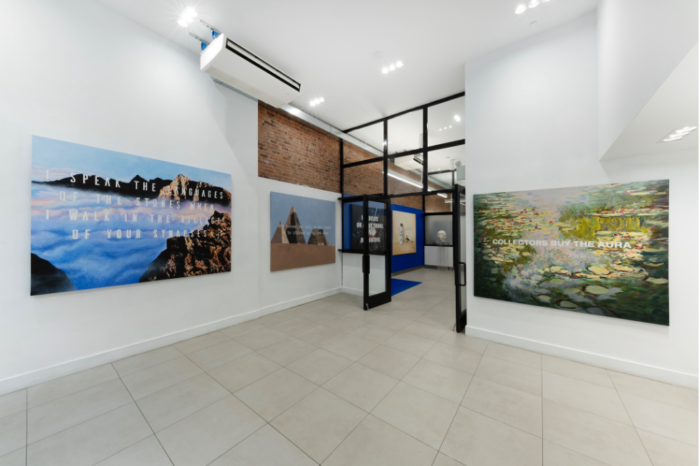
Warren Neidich (WN): I am calling my talk “Stupid Painting, Cognitive Dissonance, and the Retinal-Cortical Interface.” In an interview that appeared in ARTnews 1968, Francis Roberts asks Marcel Duchamp about what “stupid painting” means: “In France, there’s an old saying, ‘Stupid like a painter.’ The painter was considered stupid, but a poet and writer very intelligent. I wanted to be intelligent… It has nothing to do with what your father did; it has nothing to do with being another Cézanne. In my visual period, there is a little of the stupidity of the painter; all my work in the period before the Nude was visual painting. Then I came to the idea of ideatic formulation, a way to get away from influences.” Then, some years later, in the book Dialogues With Pierre Cabanne, 1968, Duchamp answers his question about the Large Glass. “I was mixing stories, anecdotes, with visual representation, while giving less importance to the visual element than one generally gives to a painting. Already, I didn’t want to be preoccupied with visual language…Cabanne retorts: ‘Retinal?’ Duchamp counters: ‘Consequently, retinal. Everything was becoming conceptual. That is, dependent on things other than the retina’ and therefore of the gray matter. Cabanne remarks, ‘It’s odd that you are taken for a purely cerebral painter, and have always been preoccupied with technical problems.'” Next, the conversation turns to readymades, a term coined by Marcel Duchamp in 1960. To describe prefabricated, often mass-produced objects, isolated from their intended use, and elevated to the status of art by the artist’s choice and designation, based on a reaction of visual indifference while at the same time a total absence of good or bad taste. Duchamp is quoted in “Art of Assemblage,” by William Seitz written as a text for a catalog for the exhibition of the same name he curated at the Museum of Modern Art. “There are three important points here. First, the choice of the object itself is a creative act. Secondly, by canceling the useful function of an object or as a text or a phrase, it becomes art. Thirdly, the presentation, in addition to a title to the object or the phrase, gives it a new thought, a new meaning.” Duchamp’s readymades also asserted the principle that what art is, is defined by the artist. Choosing the object or the phrase is itself a creative act. Canceling out the useful function of the phrase makes it art, and its presentation to the gallery gives it new meaning. This moves the artist from a maker to a chooser and is often seen as the beginning of the movement of conceptual art. Okay, Edward Ruscha in Los Angeles. So, for the newcomers who just arrived, I’m talking about Ruscha in relation to Krochmalny, their differences, and their similarities, and first I will address the ready-made phrase as used by Ruscha, its relation to the ready-made object in the classical sense used by Duchamp, connecting them to conceptualism and pop art. (Johns was influenced by the work of Duchamp, especially his Large Glass and readymades, after visiting the Philadelphia Museum of Art.) Then I will look at the non-representational text-based work of Syd Krochmalny which is performative, poetic, and open to interpretation. What I would like to say are divergent texts instead of convergent texts pilfered from pop culture in the case of Ruscha. Edward Ruscha in Los Angeles, discovered the work of Jasper Johns, especially his use of mass-produced imagery, and his own subsequent incorporation of popular language, another sort of found material, into his work was the result. Just as Johns often starts with a found object, Ruscha often begins with a found word or expression he found on billboards, highway signs, and television commercials. Certain words rang true and they would become the content of his works such as contemporary slang like “boss,” “ace.” He has said of the latter, “At one time, I loved the word ‘ace.’ It meant something to me. That was powerful. I made a few paintings of the word.” Here, as much as the word, a common word, serves as an infinite regress behind the picture, demonstrating Ruscha’s preoccupation with vernacular language as image, relates to the Johns’ concept of the simplified, familiar, and concrete subject matter. Like most of Ruscha’s books, “26 Gasoline Stations” was designed to convey the most objective, independent view of its subject. The artist muses in a 1965 interview, “I want absolutely neutral material. Here’s the readymade that lets me make friends.” He says, “I want absolutely neutral material. My pictures are not interesting, nor the subject matter. They are simply a collection of facts.” He frequently expressed the hope that his books would remind viewers of training manuals for industrial or household for hustled machines and likened any images in them to industrial photography. And here are some of his titles and some of his works: “Another Dream Bubble Pot,” “Hawk,” “Some Pretty Eyes and Some Electric Bills.” Ruscha’s placement of words against a mountainous landscape in “Pay Nothing Until April” suggests the opening credits to an action-adventure film or an advert billboard. And this becomes a starting point for the analysis of the found phrases of Ruscha used in his paintings and those of Krochmalny. For instance, Ruscha’s painting “Pay Nothing Until April” is sarcastically rendered in front of a white cap mountain one can witness on a clear winter day in Los Angeles or appropriated from postcards of mountain ranges found at flea markets. The expression is a common sales slogan to induce the buyer to buy something right away as it is not necessary to put any money down at the time of purchase. Was he referring to his own painting? It is a template with an uncanny resemblance at least an inspiration for Krochmalny’s, “I speak the languages of stones when I walk in the village of your synapses.” Again the phrase is painted in front of a beautiful landscape. But Krochmalny’s phrase is a poetic act of creativity rather than an act of appropriation. It is made for contemplation and refutes logic. Both are successful and pleasing, not cold and disinterested. And yet his verse rather than being familiar or concrete is infused with ambiguity. It stimulates divergent thinking instead of convergent thinking. Where’s the stupid painting? Both paintings are smart in fact conceptual in the sense of using text and being anti-representational. However, Ruscha’s linguistic readymades do not engage the deeper levels of contemplation as they are passively registered as something already known and familiar. That’s their market readiness. There’s a difference between a passive reader and an active reader. The readymade is a conceptual trope as its only sense is the ecology of associations that it renders available to understanding. Ruscha’s textual readymades are concrete, logical, and make sense in the broader context of the commercial American urban and mediated landscape. In Krochmalny’s work, a different process is going on. The viewer, spectator, or reader has to be active in order to make sense of the almost anti-grammatical verse that decorates the painting surface. They are not made for the consumer as Ruscha’s work is but for the fellow poet. And what I’m arguing is, in simple words, you have the subject, the person, the audience, has to be active, has to be an active reader, has to take his own subjectivity and incorporate it and understand it in terms of themselves. Whereas Ruscha, it’s about a passive reader. It’s something that is coming out of popular culture. It’s something that everybody has already understood and knows, and it’s something that is passively understood without effort; you don’t have to say anymore, the reader doesn’t have to go in further, and that’s also the difference between poetry and essay, or fiction and nonfiction. So, the last part of my little text here is in provocation because I hope we can discuss some of these things. I hope it’s interesting to you. One of the signs you may be experiencing cognitive dissonance, and I think this is the key, I think that this idea of cognitive dissonance, which I’m going to define for you in a minute, and retinal dissidence, and how they function, is really the difference between how I found Syd’s work operating in contradiction to how Ruscha’s image operates. Anyway, visual and cognitive consonance and dissonance. So, visual consonance is the Ruscha, the passive reader. The found text, which is incorporated and reinterpreted into the painterly surface, becomes materialized into the fact found on the canvas, the painting. The other concept, which I’m calling visual and cognitive dissonance, is when there’s a “Collector Buy The Aura” or “Beyond The Value.” They are questions, not only just the text, require you to be activated as an individual or activate the text, but it’s asking you questions to think about. Neither are any longer about a retinal stimulation, although the retinal transduction of image electromagnetic energy to action potential and the ionic conduction wave to travel from the retina to the early visual processing occurring at the Lateral Geniculate Nucleus and the visual cortex. And it’s a question. It’s a dissonance; it’s beyond the value, or this other sentence: “I speak the languages of the stones when I walk in the village of your synapses.” So, these are very ambiguous; they require an active reader. A discerning and knowledgeable viewer, spectator who needs to do mental labor. Cognitive Dissonance is the unpleasant emotion that results from holding two contradictory beliefs, attitudes, or behaviors at the same time. Krochmalny’s works present psychological and semantic conflicts resulting from incongruous beliefs and attitudes held simultaneously. His work breaks up the dialectic and operates along an entire continuum of possibilities. General discomfort that has no obvious or clear source, confusion, feeling conflicted over a disputed subject matter, people saying you’re a hypocrite, being aware of contradictory views and desires but not knowing what to do with that. Thank you.
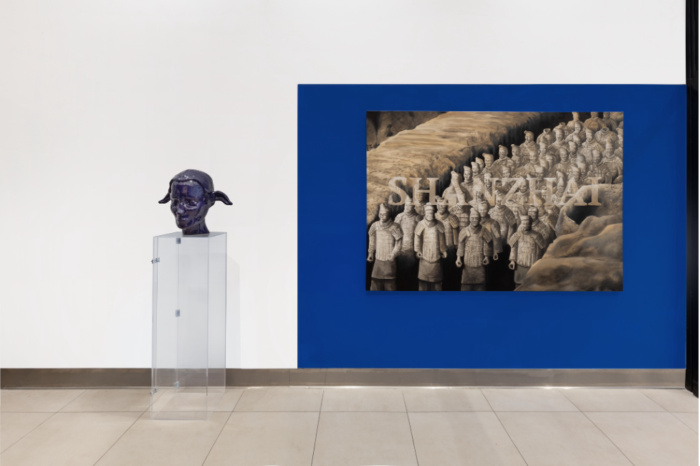
Reinaldo Laddaga: As I observed the paintings, I began to notice elements that had initially escaped me. These elements were somewhat nebulous, resembling floating impressions. This experience reminded me of the time I visited a Ruscha exhibition after traveling in the Sonoran Desert, south of Palm Springs, near the Mexican border. There, Ruscha’s work struck me with its somber tone, particularly the way words appeared in the desert environment—under the blinding sun, against a horizonless sky. The letters had a certain materiality, yet they seemed spectral, almost ethereal.
I recall how Ruscha’s words assertively imposed themselves, reminiscent of the Sunset Boulevard landscape, yet distinctly different in the desert context. In the desert, you find yourself in a public space that simulates intimacy while opening you to a cosmic dimension. This setting, surrounded by alien museums and paranormal tourism, resonates with some aspects of Krochmalny’s work. In Syd’s creations, I sense a similar yet divergent mental space, a world where subcultures and the divine coalesce, a theme Ruscha also explores.
However, my perspective recently shifted, particularly regarding Ruscha’s portrayal of significant words. These paintings began to evoke a computer screen rather than a cinema screen, unlike Ruscha’s typical white screen backdrop. This shift altered how the words interacted with their environment, differing from Ruscha’s approach and creating a distinct, floating effect.
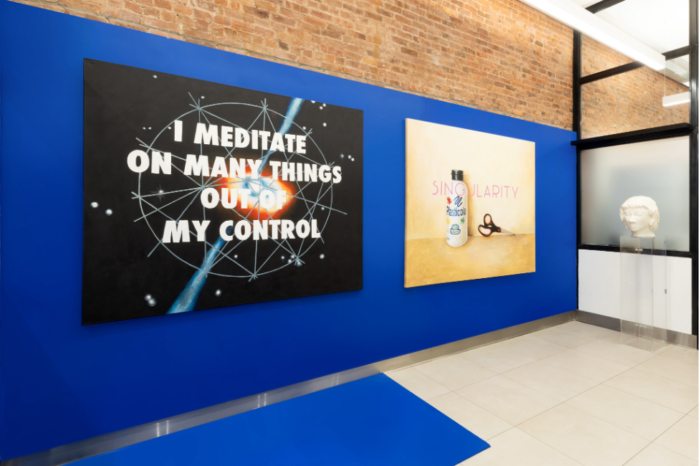
Vivi Tellas (VT): Thank you for inviting me. Colleagues, I have a question for Syd. When I first encountered his work, I was overjoyed. I was fantasizing about witnessing Syd at work, creating these paintings. So, today, I propose a small performance. Syd, would you be willing to reenact how you paint?
Syd Krochmalny (SK): Yes.
VT: Really?
SK: Yes.
VT: Could you select one painting, perhaps the one that involved the most action during its creation, and demonstrate how you painted it?
SK: You can choose any; this one is fine.
VT: I’d like you to illustrate with your body.
SK: Before I start painting physically, I reflect. It’s not just about the physical act of painting. That act stems from an idea that turns into practice and experience. I listen to what the artwork demands. For instance, I remember pondering how to approach one of these other works, which perhaps someone else might discuss later. This work, the one representing the Alien, and another, titled “Art Makes You Perform” (which is not part of this exhibition), dictated the way they were to be created.
VT: So, it’s like shadowing something?
SK: Exactly. It’s as if a non-human entity guides me. Let’s say that this alien figure guides me on what and how to paint. For instance, he/she/they once asked, “What’s the most erotic artwork of the 19th century to paint?” We settled on Monet because it implies it’s attractive from afar, but up close, not so much. But I had to adapt it, so I edited it a bit in Photoshop, inspired by a version I saw at the Met. However, I wanted to paint it as if I were copying it from a digital screen. I simplified it as he advised. Then, I projected the altered Monet image, sketched it lightly with a pencil, capturing all the details. After sketching, I prepared the colors – organizing the yellows, greens, etc., on the matrix. This particular work is mainly a cropped version, adjusted to resonate with what collectors seek in terms of aura, while still retaining a close resemblance to Monet. I transformed Monet, but this piece differs significantly from my other works.
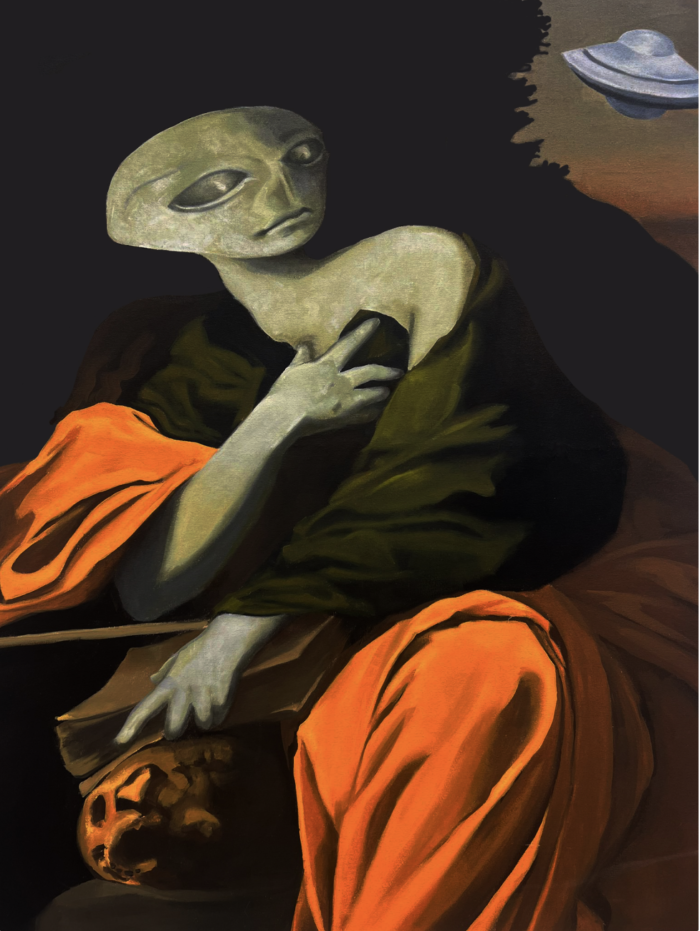
Paul Miller (PM): Can I ask you two questions? Let’s talk about the process. Similar to what I was discussing earlier, you’re looking at found objects on one end and software on the other. I’m assuming you’re using Photoshop, Adobe, and then adopting a kind of diptych approach, which is fascinating. There are other artists like Jenny Holzer and Barbara Kruger, and then delving deeper into the philosophical, like Joseph Kosuth with his ‘Art After Philosophy.’ When you think about language entering the space of the painting, I’m intrigued by your software approach. I’d like to hear how software influences your thinking as you transition from the digital to the physical. There’s a famous phrase, “anything that can be digital will be digital.” When considering software’s impact on painting, there are so many examples. Your appropriation of photography, editing language, and such paths is really intriguing. For example, Joseph Kosuth is a major figure in language, similar to Ruscha, and then there’s Julio Cortázar’s ‘Hopscotch,’ playing games with linearity. Regarding the tomb of the Chinese emperor and art collectors, I’d like to hear your take, as software seems critical.
SK: It’s fascinating how each of my paintings arises from different series and needs, reflecting my exploration of philosophical and poetic themes. For example, the works titled “I Meditated on Many Things Out of My Control,” “I Speak the Languages of the Stones When I Walk in the Village of Your Synapses,” and “She Left Her Body on the Beach to be Cleaned Up by the Alien” are the result of my inquiries into philosophy and poetry, influenced by a music album I released in 2017.
These works invite us to reflect on the existence before life on Earth, inspired by the thought of ancestry and contingency. My art, through painting and music, proposes a type of speculative art that transcends the limits of the scientific method, questioning how we can contemplate a reality that exists beyond conscious thought.
In “She Left Her Body on the Beach to be Cleaned Up by the Alien,” I narrate a clandestine encounter between a human and an extraterrestrial being on a beach near the Nile River in a distant past. This encounter challenges our perception of humanity and its place in the universe, alluding to religious beliefs and science fiction.
The paintings “Singularity” and “Shanzhai” are intertwined with the theoretical frameworks of my classes, where I explore techniques such as collage and montage, both in art and in the digital era. These works reflect the constant evolution of artistic expression in a world saturated with texts and images.
In “Shanzhai,” I address the idea of originality and reproduction, inspired by Buddhist philosophy that values the transience and constant metamorphosis of being, challenging the Western notion of objectivity and moral subjectivity.
My pieces “Collectors Buy the Aura” and “Beyond the Value” represent aspects of my practice in the art market, questioning what determines the value of art and how it is established in a constantly changing artistic world, yet governed by the search for the immutable.
In Argentina, the artistic tradition requires being multifaceted, encompassing everything from teaching philosophy to managing galleries. This diversity is reflected in my artistic approach, where I combine poetry, music, performing arts, and being a gallerist on Argentinian art as a performance of everyday life.
In what we could call ethnographic performance, I choose a role or character and perform it over a period of time in real life, without intermediaries. I have been carrying out this procedure since the early 2000s, which has allowed me to develop projects such as Pulpo Vulvo (2000-2005), Chastity (2006-2007), Bridegrooms Stripped Bare by their Bachelorette (2007-2019), and The Size of My World (2007-2021). Currently, I am conducting this subjectivation experiment, focusing on the role of being an art gallery director.
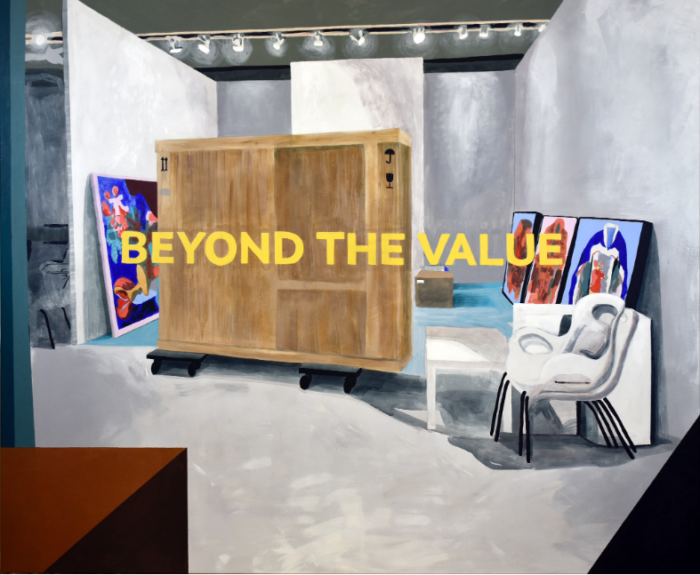
What I do is design a character that I experience throughout my entire life for a specific period. It’s a mix of autobiographical design. That is, I design a subjectivity and apply it to the lifeworld (the world as immediately or directly experienced in the subjectivity of everyday life); it’s a procedure that uses tools from ethnography (participant observation) and theater (dramaturgy and performance). It’s a dramaturgy of everyday life, or it can also be understood as a fictionalized ethnography. This is made clear in my works “Chastity,” where I create a fictional character (around my name, my sexuality, and aspects of life) to carry out a reflexive and formative pact of cohabitation and artistic co-production based on friendship, sharing resources and capabilities for the period of a year starting on August 4, 2006. The pact was based on the model of platonic love (affective and pedagogical intergenerational relationships between people of the same sex from which sexual contact is excluded). Such relationships are virtually nonexistent in contemporary Western societies, despite their paradoxically close associations with the origins of Western philosophical traditions.
In the same way, I did it in my projects where I researched the world of male prostitution for which I created a book and paintings made of textiles and watercolors. I created an alter ego and immersed myself in the world of male prostitutes to investigate it and produce aesthetic and political artifacts.
Therefore, this approach not only allows me to examine social and cultural dynamics from within but also to reflect on how identities can be shaped and reshaped in different contexts. By adopting the identity of a gallery owner, I do not merely mimic the actions and behaviors associated with that role but also interact with the art world in a way that questions and reveals the implicit expectations, norms, and values within that realm. At the same time, I generate an impossible subjectivity by merging my own subjectivity with that of the fictional character (re) presented in everyday life (Lebenswelt). I am akin to an actor and spy within a subculture, an ethnographer-actor, performing without an audience aware of my role, embodying a spy who approaches his/her/their object of study with empathy.
This immersion process in a character facilitates a deeper understanding of the intersection between art and life, turning every interaction and decision made from my alter ego’s perspective into a piece of art in itself. It’s an exploration of the inherent performativity in our daily lives, an inquiry into how the roles we assume, whether consciously or unconsciously, influence our perception of ourselves and others.
Inspired by Erving Goffman’s dramaturgical analysis, my practice highlights how social life is essentially theatrical, with individuals playing roles in everyday settings. By making public the process of assuming a specific role and the resulting reflections, I invite viewers to question the boundaries between authenticity and performance, between being and seeming.
This approach also allows for a critique of artistic institutions and how they shape the creation, perception, and valuation of art. By positioning myself within the system as a fictitious gallery director (in terms of the artistic performance) but real (in terms of the incidence in the pragmatic world), I can offer a unique perspective on power dynamics, the commercialization of art, and the relationships between artists, gallery owners, and collectors.
Consequently, my role as a fictitious gallery director becomes a means to investigate and challenge social and cultural conventions, using performance as a tool to blur the lines between reality and representation. This practice not only enriches my artistic work but also provides a platform for dialogue about the performative nature of identity and social life.
This procedure yields different outcomes, and for the moment, this exhibition titled “Collectors Buy The Aura” is the result of this performance.
Regarding the act of painting, it is a performance in itself, as Vivi Tellas just pointed out in this talk. But the performance also takes place in a painting and in sculptures. During my postdoctoral studies, I transformed my poems into music and then into ‘painted songs,’ exploring synesthesia between colors and sounds, drawing inspiration from artists like Kandinsky and O’Keeffe. This transition from text to music and then to image, using both digital and physical media, represents a constant search for new forms of artistic expression.
My collaborations with Sony and my classes at the Centro de Investigaciones Artísticas (Artistic Research Center) in Argentina reflect this fusion of theory and practice, where my paintings become a medium to explore complex concepts, challenging traditional dichotomies such as fiction/non-fiction, object/subject, nature/society, art/non-art, and artist/artwork.

My sculptures, which began as an NFT project, demonstrate my interest in art history and technology, linking the past with the present and the future. In 2014, when I learned about the existence of NFTs, I made some drawings that I called my first NFTs, which I later transformed into digital sculptures and then printed in 3D in 2016, to finally turn those files into animated sculptures.
In my work, each piece is a window into a world of ideas and reflections, where art is not only created but also creates and transforms the artist. The work exercises its own agency in its creation.
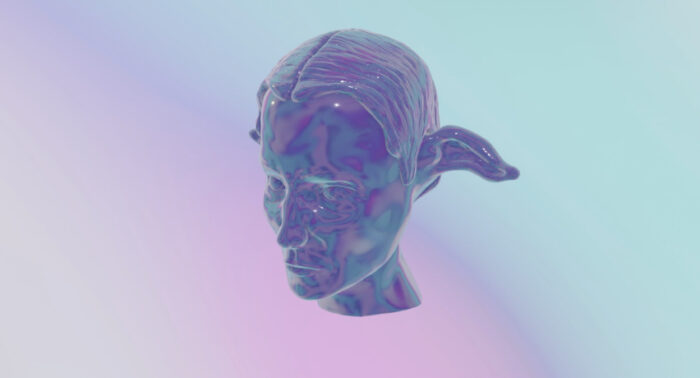
Sozita Goudouna: The other night, I found myself passionately discussing the themes of screens and intermediality. This is because there’s a cinematic approach evident here. You seem to have embraced the American ethos and the nuances of its subcultures, including those revolving around conspiracy theories. This is an aspect that you have thoughtfully elaborated upon.
SK: The aesthetic of conspiracy theories fascinates me, particularly for its striking similarity to the grotesque in art. In my work, I explore this connection, focusing on how both realms utilize exaggeration and push boundaries to express complex ideas. For instance, the nightmarish landscapes in Hieronymus Bosch’s ‘The Garden of Earthly Delights’ or the chaotic scenes in Bruegel’s ‘Dulle Griet’ (Mad Meg) mirror the surreal and often disturbing nature of modern conspiracy theories. Similarly, Goya’s ‘Saturn Devouring His Son,’ with its raw, dark emotions, echoes the intense fear and paranoia found in such theories.
These historical artworks provide a lens through which I examine contemporary issues like hate speech and misinformation. I’ve studied the evolution of hate speech since 2008, tracing its impact on society and its frequent intersection with conspiracy theories. This research has influenced my installations, poetry, and performances, where I aim to dissect the political underpinnings of these phenomena.
Hate speech often stems from a deep-seated fear – fear of the ‘other,’ of losing societal status, or of change. This fear can lead to scapegoating, targeting groups like immigrants or the marginalized. In my observation, there’s a concerning rise in neo-fascist aesthetics and politics in today’s world. These movements simplify complex historical and social issues into black-and-white narratives that can be both appealing and dangerous. As an artist, I believe it’s crucial to engage with these themes, to challenge and critique them. We’re at a crossroads, much like humanity once transitioned from the rationality of Ancient Greece to the darkness of the Middle Ages. Our collective response to these modern challenges, in both the artistic and political spheres, will determine the path ahead – whether we descend into a new era of obscurity or find a way to navigate through these tumultuous times.
Kurt McVey: Have you ever been visited or abducted by aliens?
SK: I can’t say for sure. But I absolutely believe art makes you perform. Sometimes one of my paintings seems to dictate what and how I should paint. It’s like my artistic director, in a sense.
Speaker: So, you could be considered the voice for the boys.
SK: It’s hard to define it as purely masculine, feminine or non binary. You see, it’s more fluid than that.
Kurt McVey: Syd, have you brought up memes in your talk today?
SK: No, yet. I haven’t specifically discussed memes. However, are there any meme elements you identify in our conversation? I would note that some of these paintings echo meme aesthetics, such as the one depicting pyramids, which hints at alien presence with the phrase “She leaves her body on the beach to be cleaned up by the Alien,” or “Collectors Buy the Aura,” which could itself be considered a meme.
Speaker: Could you define ‘meme’ for us? Is it relevant in this context? What are your thoughts?
SK: Here are two definitions of memes I find particularly meaningful. Richard Dawkins, in his seminal work “The Selfish Gene,” describes memes as units of cultural transmission or imitation. These are ideas, behaviors, styles, or practices that proliferate within a culture similarly to how genes spread in biological evolution. Memes replicate, mutate, and adapt in response to various cultural pressures. This framework is essential for grasping how cultural phenomena evolve and why certain ideas or trends achieve widespread popularity. Within our discussion’s scope, phenomena like conspiracy theories and hate speech spread and morph in ways akin to memes, virally moving through cultures and communities. I have developed paintings that draw inspiration from memes, which I aim to exhibit.
Additionally, another perspective on memes pertains to their aesthetic on the internet, characterized by the use of appropriated images accompanied by text. Internet memes are a practical application of Dawkins’ meme theory, as they swiftly reflect and encapsulate contemporary cultural events, playing a role in shaping the narrative of the times. In this collection, I view some paintings as poetical, theoretical, or artistic memes of the internet era, offering a unique lens through which to view our current cultural landscape.

WN: I wanted to address something to Paul Miller because I find what you said interesting, though I view it from a distinctly different perspective. There are two aspects of your statement that caught my attention. Firstly, I don’t see much technology in this work. I agree with you, but before delving into that, I must clarify: I don’t see the artist using chatGPT or other advanced technologies. However, as Reinaldo pointed out, I do concur that they possess a screen-like appearance. These paintings, to me, are about memory and what Michelangelo Antonioni termed ‘prosthetic memory.’ This concept, which he discussed in his film ‘Blow-Up,’ involves the scene where Michael, the photographer, plays a fictitious tennis match, hitting imaginary balls. This could be interpreted as a psychotic breakdown, but it’s more about how memories influenced by cinema become more potent than those from our real-life experiences. It is their subsumption of real memories at the neural synaptic junctions that causes a schisis in the mind no longer able to distinguish the real from the fake. The memories from the virtual screen, or screen memories, are a kind of hyper-prosthetic memory in the sense they are more powerful than the cinematic. I believe these paintings reflect this idea, demonstrating that technology affects our memory system and becomes the canvas for our imagination.
PM: So, here’s a counterpoint. To everyone in this room, if you can read the text in these works, you’ll notice fonts like Helvetica, which dates back to the 1960s, or perhaps 2019. It’s interesting because this predates the first iPhones, which came out in 2007. With the rise of mass photography, one could argue that these works lie somewhere between traditional painting and photography. For example, the Crimean War, notably documented in Ukraine, pioneered the dissemination of images through networks like Telegram or Instagram in Russia, becoming the first ‘Instagram of war.’ But what’s intriguing is when you consider fonts, paintings, and memory, these memories are unstable due to software’s ability to transform anything into anything else. From my perspective, why not think of these texts as prompts for chatGPT, and see what linguistic analysis and mathematics it generates? ChatGPT, or generative pre-trained GPT, offers an amusing perspective on poetry. Imagine feeding Syd’s poetry into chatGPT to create a digital doppelganger. This touches on the concept of large language models (LLMs). The ability to distill and incorporate all these elements into a visual narrative on a canvas is fascinating. Walking into this, I didn’t know what to expect. The promo image for the flyer suggested we were exploring new territory, particularly the intersection of language, photography, and painting. This reminds me of Joseph Kosuth’s work, but while Kosuth transcribed philosophical texts, these works lean more towards poetry. Kosuth’s error was in believing art follows philosophy, but I argue that art precedes it, which is why conceptual art lost its way. Lucy Lippard’s book on the dematerialization of art over six years illustrates this shift. We are in an era influenced by invisible, coercive forces, which were foreseen by Joel Chandler and Lucille. Their work, especially in cinema, focused on text and its cinematic qualities. They utilized language and film in unique ways, akin to a visual essay, which is evident in these works. With that, I’ll step back and let the discussion continue. It’s been enlightening, especially considering the role of mobile phones and digital platforms in our current era.
SK: These works explore the process of artistic translation, moving through various forms of expression and creative metamorphosis. They begin with a performance, which transforms into a tangible experience. This experience is captured in a script, which is then translated into action. Such action is condensed into a text, which is refined into poetry. From this poetry, songs emerge that, in turn, inspire paintings. These paintings provoke theoretical reflections, completing a cycle of artistic evolution in which each phase nourishes the next, establishing a link between diverse means of expression and thought. Today, tools like DALL·E perform translations from natural language to images, participating in this process of transformation. However, my translations encompass a broader spectrum, from life to theatricality, through language, and on to the image. In the final link, from language to image, I do not start from natural language, but from the poetic, and my approach is not a literal translation, like that of DALL·E; it is of a different nature. I consider that DALL·E operates under a different mechanism in this context of artistic translation.
Recent conversations have been enriching and have led me to reflect on how contemporary paintings are blurring the lines between various practices and artistic theories. These works seem to be dissolving traditional antinomies: between intuitive painting and conceptual art, between canvas and digital screen, and between cinema screen and mobile phone. We observe an interesting fusion between the representation of images obtained from the internet and the painting of lived experiences, between the creation of poetry and theory, and between transforming a performance into a pictorial work.
These paintings challenge us to reconsider what it means to paint what is seen versus what is imagined, or even to transform an idea with software. In contemporary art, these differences between methods and mediums, which were once crucial, are now losing their relevance. We see how they are merging into a broader and more fluid creative space, suggesting a significant shift in how we understand and value art.
Article by Warren Neidich, Reinaldo Laddaga, and Vivi Tellas

American artist and theorist Warren Neidich works between Berlin and New York City. He was trained in fine art, architecture, and neuroscience. In the past five years, he has used texts, neon-light sculptures, paintings, and photographs to create cross-pollinating conceptual works that reflect upon situations at the border zones of art, critical neuroscience, and cognitive justice. He is the founder and director of the Saas-Fee Summer Institute of Art since 2015.

Reinaldo Laddaga is an Argentine writer based in New York. The author of numerous books of narrative and criticism, he taught for many years in the Romance Language Department of the University of Pennsylvania. His latest works are Los hombres de Rusia (The Men from Russia), a novel, and Atlas del eclipse (Atlas of the Eclipse), a book about walking in New York at the height of the COVID crisis.
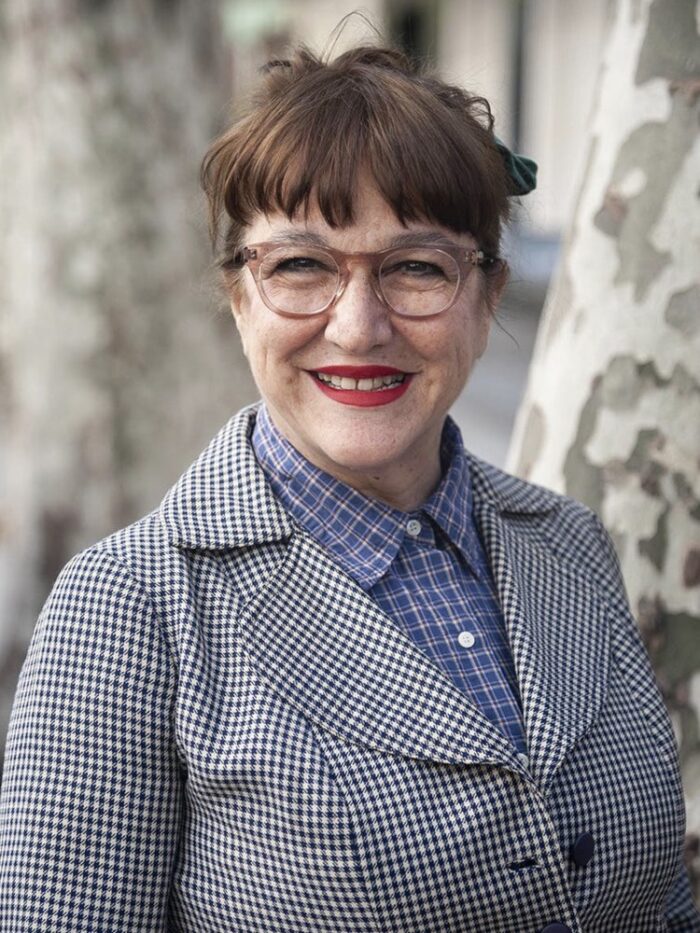
Vivi Tellas is a theater director, researcher, and curator from Argentina. She is the creator of biodrama, a documentary theater genre. Her research interests are documentary theater, Latin American poetry, and biographies. She published Biodrama, Proyecto Archivos. Seis documentales escénicos (2017). She was awarded with the Belknap Fellowship Award by the Princeton University Humanities Council in 2014. Her current research project is based on theatricality in the life and work of Argentinian poet Alejandra Pizarnik.

